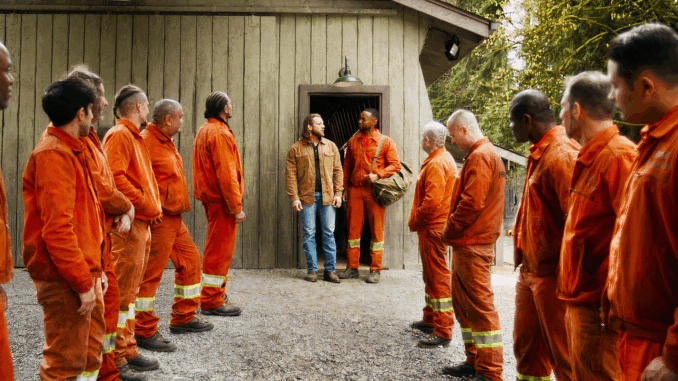
A Story Rooted in Truth
One of Fire Country’s most powerful and controversial themes is its depiction of inmate fire camps—real-life programs in California where incarcerated individuals volunteer to fight wildfires in exchange for reduced sentences and a shot at rehabilitation.
While other shows avoid such raw material, Fire Country leans in, using the program as both a narrative engine and a mirror for societal reflection. But what many viewers don’t realize is how much research, consultation, and sensitivity goes into writing these stories.
More Than Just Fiction: The Real Programs Behind the Drama
California’s Conservation Camp Program has existed for decades, operated jointly by Cal Fire and the Department of Corrections. Thousands of low-risk inmates have served on fire lines, often risking their lives for less than $5 a day. Despite their service, many of them face significant barriers to employment after release.
When developing Fire Country, co-creator Max Thieriot—who grew up in fire-prone Northern California—wanted to highlight both the heroism and exploitation baked into the system.
“I saw these guys on the front lines. I knew there was more to their story than anyone was telling,” Thieriot said in a panel.
Building Complex Characters, Not Stereotypes
From Bode Donovan to Freddy Mills and beyond, the show’s writers make a conscious effort to humanize incarcerated characters without romanticizing them.
-
Bode is flawed, impulsive, and often self-sabotaging—but he’s also brave, loyal, and seeking redemption.
-
Freddy is intellectual and hopeful, but frequently faces systemic obstacles that threaten his progress.
-
Newer inmates show the diversity of backgrounds, motivations, and traumas that shape each journey.
Behind the scenes, the writers’ room includes consultants who were formerly incarcerated, ensuring authenticity in dialogue, behavior, and legal context.
Facing the Controversy Head-On

Some critics have accused Fire Country of glorifying prison labor. In response, the show has done something few network dramas dare: address the issue in-universe.
In a Season 3 subplot, a journalist interviews Bode and others, raising questions about:
-
Exploitation vs. opportunity.
-
Whether Cal Fire truly supports inmate rehab, or just benefits from cheap labor.
-
What happens to these men after they “serve their time.”
These moments are not easy answers. They are honest questions, delivered through storytelling rather than lectures.
The Emotional Stakes of Redemption
At its core, Fire Country isn’t about fires—it’s about whether people can truly change. Inmate arcs aren’t side stories—they are the thematic spine of the show. Each time Bode enters the smoke, viewers are reminded:
Redemption isn’t given. It’s earned—breath by breath, choice by choice.
This makes his victories feel harder. His relapses feel sharper. And his friendships—especially with other inmates—more profound.
Real-World Impact
The show’s commitment to this subject has led to real-world awareness:
-
Viewers donating to organizations that support formerly incarcerated firefighters.
-
Policy debates reigniting around the ethics of prison labor.
-
Conversations about mental health, PTSD, and trauma among the incarcerated rising in online forums.
By blurring the line between fiction and reality, Fire Country becomes more than entertainment—it becomes a platform.
Conclusion: Fire as a Metaphor, Redemption as a Reality
In telling the stories of inmate firefighters, Fire Country is engaging in a rare kind of television: socially conscious, emotionally honest, and narratively gripping.
The fire is real. So is the system. But so, too, is the chance to walk through hell and come out better on the other side.
